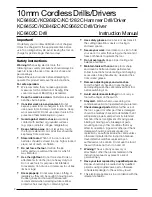
6
To fasten all chucks
Put the chuck on the thread and turn it
clockwise till it stops. Tighten firmly. Put in
the screw and turn it anti-clockwise till
absolutely firm.
Hints on use
For longest product life, do not force the tool!
•
Lock the trigger switch “Off” with the switch
control lever when attaching or changing bits
or accessories and when storing.
•
Use sharp drill bits only.
•
For
wood
, use twist drill bits, spade bits, power
auger bits, or hole saws.
•
For
metal
use high speed steel twist bits.
•
For
masonry
, such as brick, cements etc.,
use carbide-tipped bits.
•
Be sure the material to be drilled is anchored
or clamped firmly. If drilling thin material use a
wood “back up” block to prevent damage to
the material and increase control on
breakthrough.
•
Centre punch an indentation at the point to be
drilled. This will overcome the tendency of the bit
to slip around on a smooth surface. Place the tip
of the bit in the indentation and pull the trigger to
switch the motor on.
•
Always apply pressure in a straight line with the
bit. Use enough pressure to keep your drill/driver
biting, but do not push hard enough to stall the
motor or deflect the bit. To minimise stalling on
breaking through the material, reduce pressure
on the drill/driver and ease the bit through the
last part of the hole.
•
Hold the drill/driver firmly to control its
twisting action.
•
During heavy drilling your unit may become hot.
Under these circumstances please allow the unit
to cool before continuing.
Drilling in wood
Holes in wood can be made with the same twist drill
bits used for metal. These bits should be sharp and
should be pulled out frequently when drilling to clear
chips from the flutes. Work that is apt to splinter
should be backed up with a block of wood. Let up
on the pressure just before the tip cuts through; this
will give a good clean hole.
Drilling in metal
Use a cutting lubricant when drilling ferrous metals.
The exceptions are iron and brass which should be
drilled dry.
•
Grasp the rear half of the chuck with one
hand and use your other hand to rotate
the front half clockwise (hold the tool
pointing away from you) (Fig. F1).
•
Insert the bit or other accessory about
2cm into the chuck and tighten securely
by holding the rear half of the chuck and
rotating the front portion anti-clockwise
(Fig. F2). To release the accessory,
repeat step 2 listed above.
To keep the keyless chuck in good condition,
occasionally tap lightly to free any dust that
may have accumulated inside.
Warning!
Do not attempt to tighten drill bits
(or any other accessory) by gripping the front
part of the chuck and turning on the tool.
Damage to the chuck and personal injury
may result.
Chuck and key
To insert a drill bit or other accessory,
follow the steps listed below:
•
Switch the control lever to the
“Off” position.
•
Turn the chuck collar to open the
chuck jaws.
•
Place the bit in the chuck as far as it
will go and then tighten the chuck collar
by hand.
•
Place the chuck key in each of the three
holes and tighten in a clockwise direction
(Fig. F3).
•
To release the bit, turn the chuck key in
an anti-clockwise direction in just one
hole then loosen the chuck by hand.
Changing the chuck (Fig. G1 - 4)
G
Open the jaws of the chuck completely.
Inside you will see the head of a screw.
Unscrew this screw by turning clockwise.
It is very important to use the right size of
screwdriver bit to prevent damage to the head!
(Fig. G1 & 3)
Keyless chuck
Place an allen key in the chuck and tighten the
jaws. Give the allen key a short powerful blow
with a rubber or wooden hammer or your
hand. The chuck will be loose and can be
screwed off the tool (Fig. G2).
Chuck and key
Put the chuck key in one of the holes of the
chuck and give it a short powerful blow either
with a hammer or your hand. The chuck will
be loose and can be screwed off the tool
(Fig. G4).






































